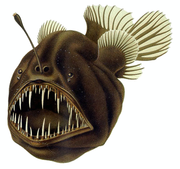Fish migration
Many types of fish undertake migrations on a regular basis, on time scales ranging from daily to annual, and with distances ranging from a few meters to thousands of kilometers.
The purpose usually relates to either feeding or breeding; in some cases the reason for migration is still unknown.
Salmon are capable of going hundreds of kilometers upriver, and human dams must install fish ladders to enable the salmon to get past.
For more information about the topic
Fish migration, read the full article at
Wikipedia.org, or see the following related articles:
 Atlantic salmon
Atlantic salmon — Atlantic salmon is a fish species of the Salmonidae family found in the northern Atlantic Ocean and in rivers that flow into the Atlantic. The ... >
read more
 Coho salmon
Coho salmon — The Coho salmon is a species of anadromous fish in the salmon family. Coho is found in the North Pacific (Alaska, Kamchatka, Kuril Islands). Coho ... >
read more
 Trout
Trout — Trout is the common name given to a number of species of freshwater fish belonging to the salmon family, Salmonidae. Trout are usually found in cool, ... >
read more
 Fish farming
Fish farming — Fish farming is the principal form of aquaculture, while other methods may fall under mariculture. It involves raising fish commercially in tanks or ... >
read more
 Deep sea fish
Deep sea fish — Deep sea fish is a term for fish that live below the photic zone of the ocean. Examples include the lanternfish, flashlight fish, cookie-cutter ... >
read more
 Neon tetra
Neon tetra — The neon tetra (Paracheirodon innesi) is a freshwater fish of the characin family (family Characidae) of order Characiformes. The type species of its ... >
read more
Marine conservation — Marine conservation, also known as marine resources conservation, is the protection and preservation of ecosystems in oceans and seas. Marine ... >
read more
 Anchovy
Anchovy — The anchovies are a family (Engraulidae) of small but common schooling saltwater plankton-feeding fish. They are found in scattered areas throughout ... >
read more
 Eel
Eel — True eels are fish of the order Anguilliformes. Most eels prefer to dwell in shallow waters, hide at the bottom layer of the ocean, sometimes in ... >
read more
 Halibut
Halibut — A halibut is a type of flatfish from the family of the righteye flounders (Pleuronectidae). This name is derived from Dutch heilbot. Halibut live in ... >
read more
The Atlanta Journal-Constitution reports:
As climate change heats our oceans, you’d expect temperature-sensitive marine species to flee poleward to cooler waters. So why have some headed to warmer regions toward the equator?
Scientists have solved the puzzle. For the most part, these animals are relocating to cooler waters. But since the effects of climate change can vary widely across regions, sometimes those cooler regions are closer to the poles and sometimes they’re closer to the equator.
In other words, marine animals are still reacting to climate change, but at a local scale. And they’re doing it so reliably that you can actually measure the speed and direction of those changes by watching where animals go, according to a study published Thursday in the journal Science.
http://junkscience.com/2013/09/13/claim-absent-manmade-global-warming-ocean-fish-always-stay-in-the-same-waters/comment-page-1/#comment-149431









Comments
Post a Comment